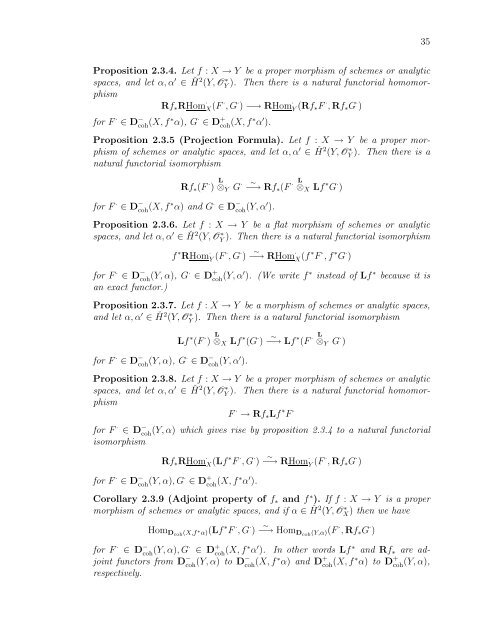derived categories of twisted sheaves on calabi-yau manifolds
derived categories of twisted sheaves on calabi-yau manifolds
derived categories of twisted sheaves on calabi-yau manifolds
You also want an ePaper? Increase the reach of your titles
YUMPU automatically turns print PDFs into web optimized ePapers that Google loves.
Propositi<strong>on</strong> 2.3.4. Let f : X → Y be a proper morphism <str<strong>on</strong>g>of</str<strong>on</strong>g> schemes or analytic<br />
spaces, and let α, α ′ ∈ ˇ H2 (Y, O∗ Y ). Then there is a natural functorial homomorphism<br />
Rf∗RHom ·<br />
X(F · , G · ) −→ RHom ·<br />
Y (Rf∗F · , Rf∗G · )<br />
for F · ∈ D −<br />
coh (X, f ∗ α), G · ∈ D +<br />
coh (X, f ∗ α ′ ).<br />
Propositi<strong>on</strong> 2.3.5 (Projecti<strong>on</strong> Formula). Let f : X → Y be a proper morphism<br />
<str<strong>on</strong>g>of</str<strong>on</strong>g> schemes or analytic spaces, and let α, α ′ ∈ ˇ H2 (Y, O∗ Y ). Then there is a<br />
natural functorial isomorphism<br />
Rf∗(F · ) L<br />
⊗Y G · ∼<br />
L<br />
·<br />
−→ Rf∗(F ⊗X Lf ∗ G · )<br />
for F · ∈ D −<br />
coh (X, f ∗ α) and G · ∈ D −<br />
coh (Y, α′ ).<br />
Propositi<strong>on</strong> 2.3.6. Let f : X → Y be a flat morphism <str<strong>on</strong>g>of</str<strong>on</strong>g> schemes or analytic<br />
spaces, and let α, α ′ ∈ ˇ H2 (Y, O∗ Y ). Then there is a natural functorial isomorphism<br />
f ∗ RHom ·<br />
Y (F · , G · ) ∼<br />
−→ RHom ·<br />
X(f ∗ F · , f ∗ G · )<br />
for F · ∈ D −<br />
coh (Y, α), G· ∈ D +<br />
coh (Y, α′ ). (We write f ∗ instead <str<strong>on</strong>g>of</str<strong>on</strong>g> Lf ∗ because it is<br />
an exact functor.)<br />
Propositi<strong>on</strong> 2.3.7. Let f : X → Y be a morphism <str<strong>on</strong>g>of</str<strong>on</strong>g> schemes or analytic spaces,<br />
and let α, α ′ ∈ ˇ H2 (Y, O∗ Y ). Then there is a natural functorial isomorphism<br />
for F · ∈ D −<br />
coh (Y, α), G· ∈ D −<br />
coh (Y, α′ ).<br />
Lf ∗ (F · ) L<br />
⊗X Lf ∗ (G · ) ∼<br />
−→ Lf ∗ L<br />
·<br />
(F ⊗Y G · )<br />
Propositi<strong>on</strong> 2.3.8. Let f : X → Y be a proper morphism <str<strong>on</strong>g>of</str<strong>on</strong>g> schemes or analytic<br />
spaces, and let α, α ′ ∈ ˇ H2 (Y, O∗ Y ). Then there is a natural functorial homomorphism<br />
F · → Rf∗Lf ∗ F ·<br />
for F · ∈ D −<br />
coh (Y, α) which gives rise by propositi<strong>on</strong> 2.3.4 to a natural functorial<br />
isomorphism<br />
Rf∗RHom · X(Lf ∗ F · , G · ) ∼<br />
−→ RHom · Y (F · , Rf∗G · )<br />
for F · ∈ D −<br />
coh (Y, α), G· ∈ D +<br />
coh (X, f ∗ α ′ ).<br />
Corollary 2.3.9 (Adjoint property <str<strong>on</strong>g>of</str<strong>on</strong>g> f∗ and f ∗ ). If f : X → Y is a proper<br />
morphism <str<strong>on</strong>g>of</str<strong>on</strong>g> schemes or analytic spaces, and if α ∈ ˇ H2 (Y, O∗ X ) then we have<br />
HomDcoh(X,f ∗ α)(Lf ∗ F · , G · ) ∼<br />
−→ HomDcoh(Y,α)(F · , Rf∗G · )<br />
for F · ∈ D −<br />
coh (Y, α), G· ∈ D +<br />
coh (X, f ∗ α ′ ). In other words Lf ∗ and Rf∗ are ad-<br />
joint functors from D −<br />
coh<br />
respectively.<br />
(Y, α) to D−<br />
coh (X, f ∗ α) and D +<br />
coh (X, f ∗ α) to D +<br />
coh<br />
35<br />
(Y, α),
















